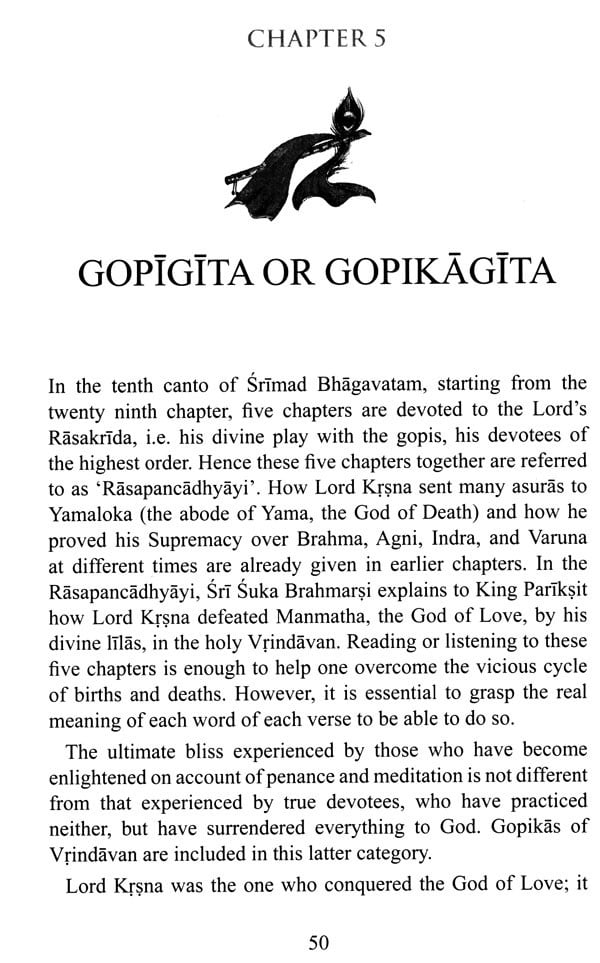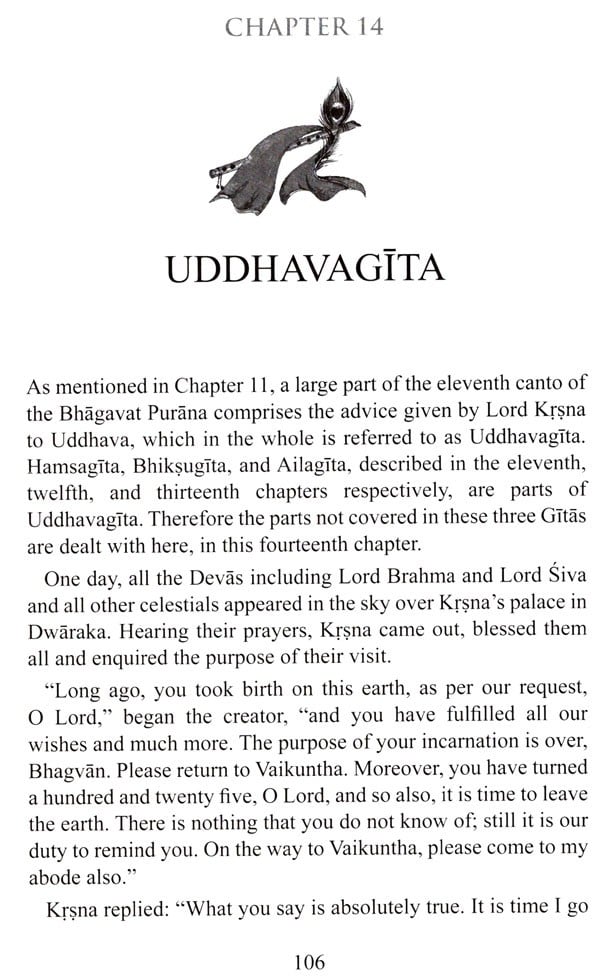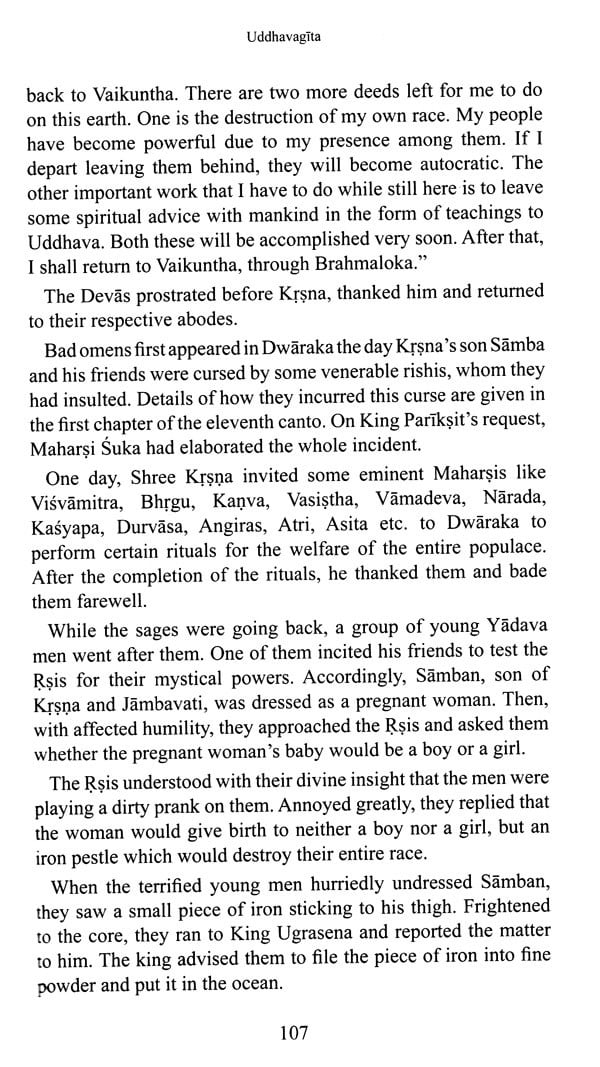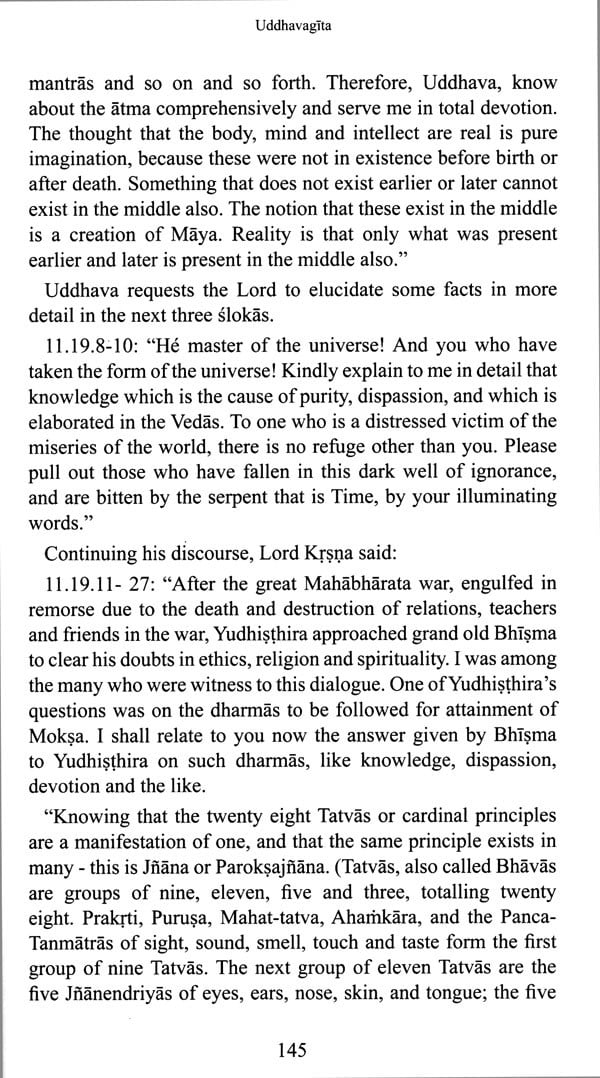
The Many Gitas in Srimad Bhagavatam
Book Specification
| Item Code: | NBZ943 |
| Author: | V. Gouri Suresh |
| Publisher: | Indus Source Books |
| Language: | English |
| Edition: | 2021 |
| ISBN: | 9789385509643 |
| Pages: | 204 |
| Cover: | PAPERBACK |
| Other Details | 8.50 X 5.50 inches |
| Weight | 230 gm |
Book Description
Vedās are the most ancient scriptures in the world. Later, different sages in different places and at different times summarized the Vedās into Upanişads. In the Purānās, meanings of the Vedās and Upanişads are explained in the form of interesting stories. Of the eighteen Purānās, Śrīmad Bhāgavatam is the most celebrated.
This great Purāna incorporates fourteen Gītas, which are spread out in different cantos. There are eighteen thousand verses in the Bhāgavatam, organized in twelve cantos. The eleventh canto contains the Uddhava Gīta, which is the advice given by Lord Kșșna to his devotee Uddhava. It includes three separate Gītās within it. The other Gītās are seen in the earlier cantos.
All of them are greatly beneficial in cleansing the human mind. Reading, understanding and contemplating on the ideas and ideals contained in them will provide everlasting happiness to mankind, leading to enlightenment and ultimate liberation.
Dr. V. Gouri Suresh is a retired Vice Principal of Jamshedpur Women's College, Jamshedpur, Jharkhand, India. She had her schooling and college education in Kerala. After completing her M.Sc. (Botany) from Calicut University in 1971, she joined Jamshedpur Women's College as a lecturer in 1975. She obtained her Ph.D. in 1993 from Ranchi University. After thirty eight years of teaching at the undergraduate level and twenty years during the same period at the postgraduate level, she retired as Associate Professor of Botany and Vice Principal in 2012.
She has presented many research papers in National and International Conferences, and published papers in various National and International journals. In addition, she was always interested in ancient Indian scriptures and epics, right from childhood. This was reflected in her first book 'Stories from Bhaagavatham' published by Bharatiya Vidya Bhavan, Mumbai in 2004. Later, as per the wish of her students, she authored two text books - 'Environmental Studies and Ethics' and 'Environmental Studies', both published by I.K. International, New Delhi in 2007 and 2011 respectively.
After retirement, Dr. Gouri Suresh has taken to writing books based on scriptures and epics again. She also visits religious places in and outside India, and writes travelogues. Her books are based mainly on religion, mythology, philosophy, and spirituality. Examples are 'The Ten Incarnations of Mahaavishnu', 'An Elderly Couple's Pilgrimage to Holy Kailas - Manasarovar' etc.
The human mind is always restless. It is the seat of thoughts, which comes and goes one after the other in never ending succession. When one's mind is thus restless, one can never concentrate on anything. If one can keep his mind calm, one can contemplate on God without distraction. The best method to do this is practising devotion to the Supreme Being. When one has controlled his mind, he is not affected by the words or actions of anyone. There is nothing that such a man cannot achieve. He is not scared of anything – not even death. He knows that just like dreams appear to be real when one is asleep, the whole world seems to be real as long as one is ignorant. When he gains true knowledge, he realises that the whole world is actually virtual. Nothing else exists except the Supreme Being. Everything else has been formed from Him and will dissolve into Him. This fundamental truth is emphasised over and over again throughout Srīmad Bhāgavatam or the Bhāgavat Purāna.
There are many Gītās in Bhāgavat Purāna. The first one is Kapilagīta, which occurs in the third canto. Here, we see Sage Kapila, an incarnation of Lord Vişnu, advising his mother on the importance of developing Vairāgya or dispassion in life. Rudragīta, seen towards the end of the fourth canto, comprises the advice given by Rudra to ten brother princes on worshipping Lord Mahāvişnu. Next is the Yamagīta of the seventh canto. Here, Yama, the God of Death, is seen explaining the meaninglessness of grieving over death, as death is unavoidable, and anyone who is born has to die.
The next seven Gītās, namely Veņugīta, Gopikāgīta, Yugalagīta, Virahagīta, Bhrāmaragīta, Srutigīta, and Mahisigīta are seen in the tenth canto. The first five of these are sung by Gopikās, devotees of the highest order of Lord Krşņa. They are in fact jīvātmās, who are always in search of the Paramātma. They experience limitless joy when they succeed in their search. In fact, this merger is the ultimate aim of every human being. Srutigīta comprises the answers given by Sage Suka to specific questions put by King Parīkșit. This Gīta, based purely on knowledge contained in the Vedās, is also part of the tenth canto. Mahișigīta is sung by the queens of Krşņa, illustrating their fondness to him.
In addition to these, the eleventh canto of Śrīmad Bhāgavatam has many Gītās. The latter part of this canto is in the form of a detailed question-answer session, which is the famous Uddhavagīta. The one who put the questions was Uddhava, one of the greatest devotees of Lord Krsna. The one who answered the questions was Krsna himself. In conclusion, Lord Krsna advised Uddhava to shun the thoughts of l' and 'mine’, and see the whole world as the seat of God. He told Uddhava that by practising this ‘adhyātma yoga’, he could become one with the Supreme Being.
Vedās are the most ancient scriptures in the world. They are four in number, namely Ķgveda, Sāmaveda, Yajurveda and Atharvaveda. In the Hindu epic Mahābhārata, the composition of Vedas is credited to Brahma, the Creator. Vyāsa, son of Sage Parāśara and Satyavati, observed that the knowledge contained in the Vedās was too profound for people to understand. To solve this problem, he explained the Vedās for the benefit of the common man. As a result of this mammoth task, he got the name Vedavyāsa.
Later, different sages in different places and at different times summarised the Vedās into what are known as Upanișads. There are twenty-one Upanişads based on Ķgveda, one hundred and nine Upanişads on Yajurveda, one thousand on Sāmaveda and fifty on Atharvaveda. Thus the total number of Upanişads is one thousand one hundred and eighty. Of these, one hundred and eight are well known, while ten are very popular.
Sage Vedavyāsa, knowing that the verses contained in the Upanişads would also be difficult to grasp, explained the meanings of the Vedās and Upanișads in the form of interesting stories. These are the Purānās. There are eighteen Purānās, of which Śrīmad Bhāgavatam is the most celebrated, and also the last to be composed. According to Sage Vedavyāsa, Lord Vișnu
himself had explained Bhāgavatam to Lord Brahma, who then narrated it to Sage Nārada. The Sage had later passed it on to him.
Just as predicted by Sage Nārada, Vedavyāsa got everlasting peace of mind after composing the Bhāgavat Purāna. This was but natural, for the real essence of this Purāna is pure, undiluted bhakti. Each canto, each chapter, each verse is immersed in bhakti. The knowledge of all the Vedās is contained in the Bhāgavatam. Reading or even merely listening to this great Purāna, or even narrating it to others, will remove all ignorance from one's mind and will inspire one to lead a virtuous life, dedicating each thought, word and deed to the Lord Supreme.
**Contents and Sample Pages**














